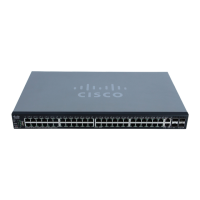
Do you have a question about the Cisco SG550X Series and is the answer not in the manual?
| Model | SG550X Series |
|---|---|
| Management | Web-based, CLI, SNMP |
| Layer Support | Layer 2 |
| Stacking | Yes |
| Power Supply | Internal |
| Type | Managed |
| Stacking Bandwidth | 40 Gbps |
| Security | ACLs, 802.1X, Port Security, DHCP Snooping |
| Quality of Service (QoS) | DSCP |
| Energy Efficiency | Energy Efficient Ethernet (EEE) |
| Memory | 256 MB Flash, 512 MB RAM |
| Operating Temperature | 0°C to 45°C |
| Storage Temperature | -4°F to 158°F (-20°C to 70°C) |
| Humidity | 10% to 90% non-condensing |
| Ports | 24, 48 |
Lists the items included in the package and outlines initial steps before setting up the switch.
Details prerequisites and required items for starting the switch installation and configuration process.
Describes the two methods for physically installing the switch: desktop placement or rack mounting.
Guidelines for optimal switch placement, considering ambient temperature, airflow, and loading.
Detailed instructions on how to mount the switch securely within a standard 19-inch rack.
Steps for connecting computers, printers, and other network devices to the switch ports.
Details on power requirements for Cisco 550X Series switches with Power over Ethernet (PoE) capabilities.
Overview of methods for accessing and managing the switch via web interface or console port.
Step-by-step guide to access and configure the switch using its web-based interface.
Instructions for configuring the switch via its command-line interface using a console port.
Guidelines for configuring multiple Cisco 550X Series switches to work together as a stack.
Overview of available product models and switch exterior features.
List and description of all available Cisco 550X Series switch models.
Details on USB, RJ-45 Ethernet, 60-Watt PoE, and SFP+ ports on the switch's front panel.
Explanation of the status lights (LEDs) on the switch's front panel for various functions.
Using the reset button and understanding back panel ports like power, RPS, and console.
Procedure for restoring the switch to its original factory default settings.
Steps to diagnose and resolve problems accessing the switch via web or console.
Links to Cisco support communities, firmware downloads, product documentation, and warranty information.